Axolotl Food Pellets are a staple diet for these captivating creatures, offering a convenient and nutritionally balanced way to keep your aquatic companion healthy and thriving. But with so many options available, choosing the right axolotl food pellets can feel overwhelming. This comprehensive guide will delve into everything you need to know about axolotl food pellets, from understanding their nutritional needs to selecting the best option for your beloved pet.
Why Axolotl Food Pellets are Essential for Your Pet
While axolotls are carnivores and enjoy a diverse diet in the wild, including insects, worms, and small crustaceans, replicating this variety in a home aquarium can be challenging. Axolotl food pellets offer a practical solution, providing a concentrated source of essential nutrients in a convenient, easy-to-store form.
 Axolotl consuming food pellets
Axolotl consuming food pellets
High-quality axolotl food pellets are formulated to meet the specific dietary requirements of these unique amphibians. They contain a balanced blend of protein, fat, vitamins, and minerals, ensuring your axolotl receives all the necessary nutrients for optimal health, growth, and vitality.
Deciphering the Ingredients: What Makes a Good Axolotl Food Pellet?
Not all axolotl food pellets are created equal. To ensure you are providing the best possible nutrition for your pet, it’s crucial to scrutinize the ingredient list.
-
Protein Powerhouse: Look for pellets with a high protein content (40-50%) derived from quality sources like fish meal, shrimp meal, or insect meal. Avoid pellets with fillers like corn, wheat, or soy as primary ingredients.
-
Healthy Fats: Essential fatty acids are crucial for an axolotl’s overall health and well-being. Opt for pellets containing sources like fish oil or krill oil, which provide omega-3 fatty acids.
-
Vitamin & Mineral Boost: Vitamins and minerals play a vital role in supporting various bodily functions, from immune health to bone development. Check for the inclusion of essential vitamins (A, D3, E, K) and minerals (calcium, phosphorus).
-
Avoid Artificial Additives: Artificial colors, flavors, and preservatives offer no nutritional value and may even be harmful to your axolotl’s health. Choose pellets with natural ingredients and preservatives.
Exploring the Different Types of Axolotl Food Pellets
Axolotl food pellets come in various forms, each designed to cater to different life stages and preferences.
-
Sinking Pellets: These pellets are ideal for adult axolotls, as they sink to the bottom of the tank, encouraging natural foraging behavior.
-
Floating Pellets: Best suited for young axolotls or those with difficulty reaching the bottom, floating pellets remain at the surface, making it easier for them to feed.
-
Soft Pellets: Designed for sensitive or picky eaters, soft pellets are easier to chew and digest, making them a good option for axolotls with dental issues or those transitioning to pellet food.
Feeding Time: Tips for a Happy and Healthy Axolotl
Feeding your axolotl should be a straightforward and enjoyable experience. Here are a few tips to keep in mind:
-
Start Small: Offer a few pellets at a time and observe how much your axolotl consumes within a few minutes. Remove any uneaten pellets to maintain water quality.
-
Adjust Feeding Frequency: Young, growing axolotls require more frequent feeding (once or twice daily), while adults can be fed every other day or a few times a week.
-
Monitor and Adapt: Pay attention to your axolotl’s appetite and body condition. Adjust the feeding frequency and quantity as needed to ensure they maintain a healthy weight.
-
Variety is Key: While axolotl food pellets should form the staple diet, offering occasional treats like earthworms, bloodworms, or blackworms can provide enrichment and add variety to their meals.
Choosing the Right Axolotl Food Pellets: Factors to Consider
Selecting the appropriate axolotl food pellets for your pet depends on various factors:
-
Age: Young, growing axolotls require higher protein content compared to adults. Opt for pellets specifically designed for juveniles or young adults.
-
Size: Choose pellet sizes appropriate for your axolotl’s mouth size. Small pellets are suitable for juveniles, while adults can handle larger pellets.
-
Health Condition: If your axolotl has specific dietary needs or health conditions, consult a veterinarian for recommendations on specialized food pellets.
 Selecting axolotl food pellets
Selecting axolotl food pellets
FAQs about Axolotl Food Pellets
Q: Can I feed my axolotl only live food?
A: While axolotls enjoy live food, relying solely on it can be challenging to ensure a balanced diet. Axolotl food pellets provide a convenient and nutritionally complete option.
Q: How long do axolotl food pellets last?
A: Unopened axolotl food pellets have a long shelf life, typically a year or more. Once opened, store them in an airtight container in a cool, dry place to maintain freshness.
Q: My axolotl refuses to eat pellets. What should I do?
A: Try soaking the pellets in a bit of tank water to soften them or switch to a different brand or type of pellet. If the issue persists, consult a veterinarian to rule out any underlying health concerns.
Beyond the Basics: More Axolotl Care Resources
For more information on axolotl care, visit our website or get in touch with our expert team:
- Website: [Insert website link here]
- Phone: 02437655121
- Email: minacones@gmail.com
- Address: 3PGH+8R9, ĐT70A, thôn Trung, Bắc Từ Liêm, Hà Nội, Việt Nam
Our team is available 24/7 to answer your questions and provide guidance on all aspects of axolotl care.